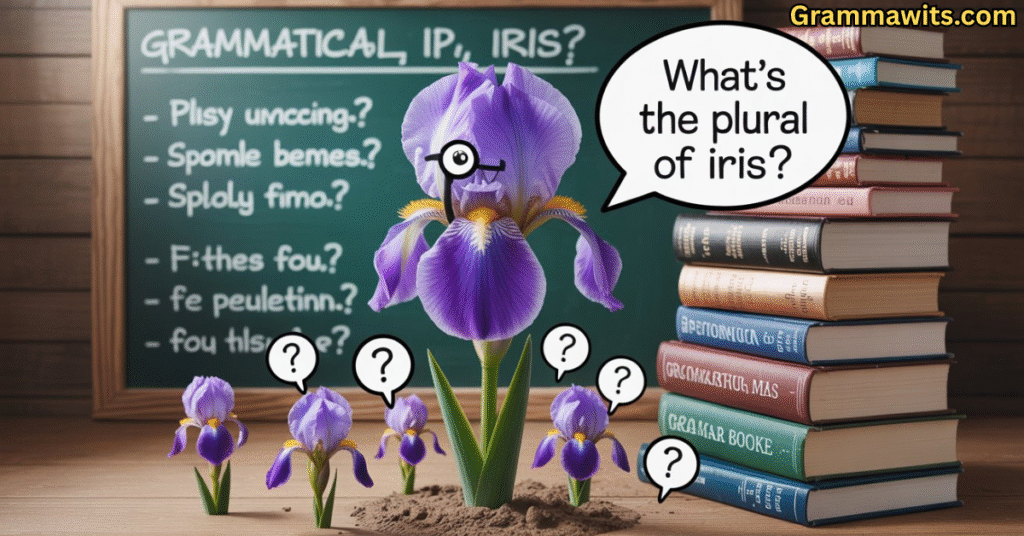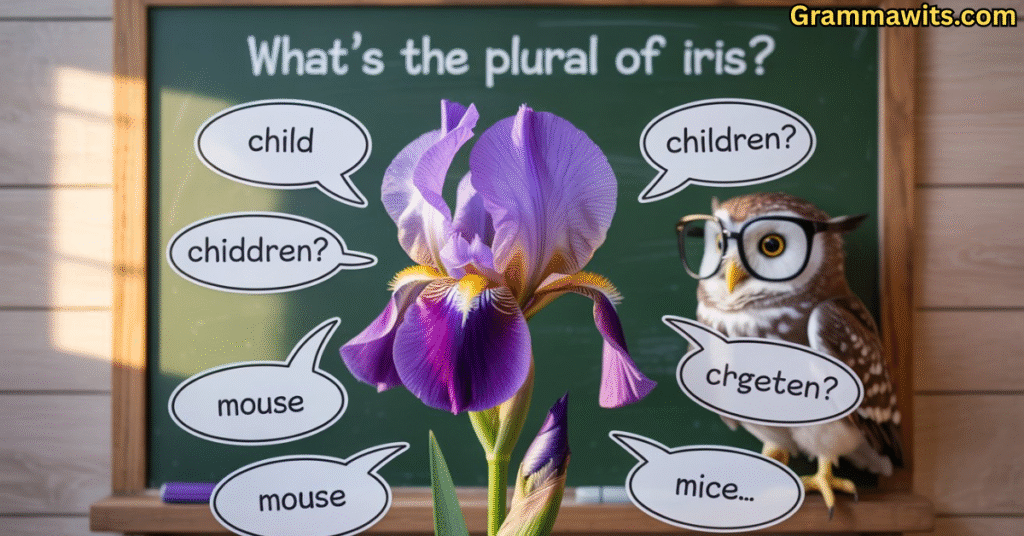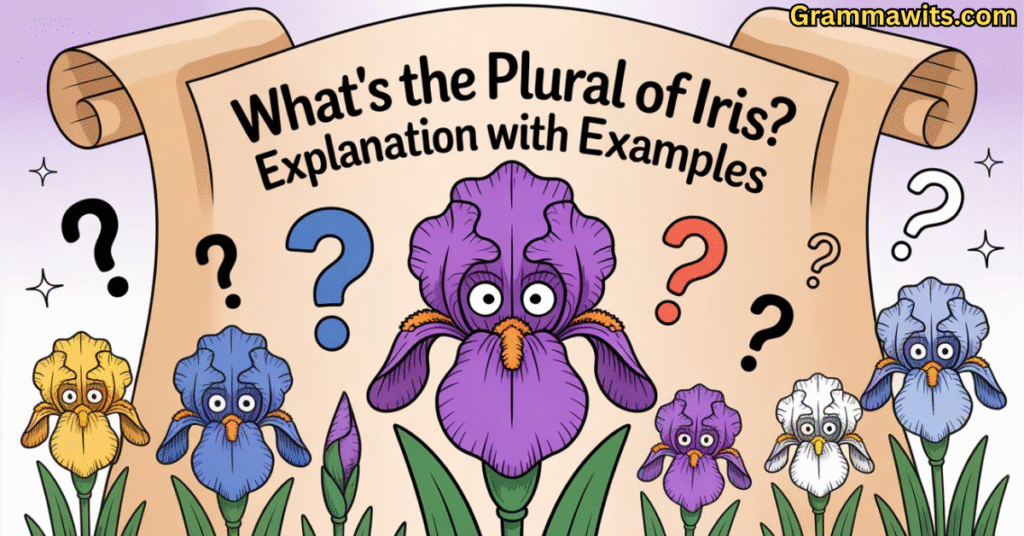The plural of “iris” can be written in two accepted forms: “irises” and “irides.” Both are correct depending on the context. “Irises” follows the regular English pluralization rule and is more common, especially when referring to the vibrant iris flower. Meanwhile, “irides” has its roots in Greek, and is often used in anatomical or classical discussions, particularly when describing the colored part of the eye.
Few words in English enjoy the luxury of dual plurals that feel equally poetic and functional. “Iris” is one of those rare gems. Whether you’re talking about blooming beauties in a garden or the striking rings of color around a pupil, the way you pluralize “iris” adds a layer of nuance to your language. That’s what makes learning this word’s variations so compelling—it merges science, art, and etymology into one linguistic flourish.
The word “iris” refers to both a plant genus and a part of the human eye. As a flower, it’s celebrated for its intricate shapes and bold colors, making it a favorite among gardeners and artists. Anatomically, the iris is the colored ring that controls how much light enters the pupil, playing a vital role in vision. Understanding both meanings deepens your appreciation for its dual-plural form.
The Two Correct Plurals Explained
Standard Plural: “Irises”
Irises represents the most common plural of iris in modern English. This form follows standard English plural rules by simply adding “-es” to words ending in “s.”
Most dictionaries list irises as the primary plural. It’s the safe choice for:
- Casual conversation
- General writing
- Educational materials
- Botanical discussions
When discussing iris flower varieties in your garden, “irises” sounds natural and familiar. Florists consistently use this form when describing their colorful displays.
Classical Plural: “Irides”
Irides comes from the original Latin word roots. In Latin, “iris” belonged to the third declension, making “irides” the historically accurate plural.
This Greek plural form appears frequently in:
- Medical journals
- Anatomical terminology
- Scientific research
- Academic publications
Optometrists often prefer “irides” when discussing eye anatomy professionally. The term carries scholarly weight and demonstrates linguistic sophistication.
Understanding the Word “Iris”

Anatomical Definition
The iris controls light entering your eye. This thin, circular structure contains muscles that adjust pupil size automatically. Eye structure varies dramatically between individuals, creating unique patterns.
Your iris eye color depends on melanin concentration. Brown eyes contain more melanin, while blue eyes have less. Green and hazel variations create stunning combinations.
Geneticists study how iris patterns inherit across generations. Each person’s iris contains approximately 266 unique characteristics – more distinctive than fingerprints.
Botanical Definition
Botanical iris belongs to the Iridaceae family. Over 300 species flourish worldwide, from tiny dwarf varieties to towering specimens reaching four feet tall.
Iris flower definition encompasses remarkable diversity:
- Bearded iris with fuzzy falls
- Siberian iris with narrow leaves
- Japanese iris with enormous blooms
- Dutch iris popular with florists
Botanical gardens showcase incredible iris flower varieties. The American Iris Society recognizes thousands of registered cultivars, each with unique characteristics.
Other Meanings
Photography enthusiasts know iris as the adjustable aperture mechanism. Camera iris controls depth of field and exposure settings.
Greek origin connects iris to the rainbow goddess. Ancient Greeks saw rainbow bridges between earth and heaven, inspiring the flower name.
Geological formations called iris display rainbow-like color bands. These iridescent minerals create spectacular visual effects under proper lighting.
Context Determines Usage
When to Use “Irises”
Common English plurals favor the “-es” ending for everyday communication. Irises works perfectly in these situations:
Garden conversations: “My purple irises bloomed early this spring.”
Photography discussions: “The camera irises need cleaning before the shoot.”
Casual medical talk: “The doctor examined both irises during my eye exam.”
Educational content: “Students learned how irises regulate light entering the eye.”
Florist shops display signs reading “Fresh irises available daily.” This familiar form connects immediately with customers.
When to Use “Irides”
Latin to English roots maintain importance in professional settings. Irides appears in:
Medical journals: “The study examined 847 irides for genetic markers.”
Research papers: “Comparative analysis revealed irides patterns vary significantly across populations.”
Academic presentations: “Anthropologists documented irides characteristics in isolated communities.”
Scientific classification: “Botanists catalog irides specimens using standardized protocols.”
Linguistics professors often cite irides when teaching Greek to English words evolution.
Real-World Examples in Action

“Irises” in Natural Sentences
Daily usage of irises appears in countless contexts:
“The iris garden displayed hundreds of colorful irises in full bloom.” This sentence demonstrates natural sentence structure for botanical terms.
“Her camera’s irises needed adjustment for the portrait session.” Visual arts professionals use this terminology regularly.
“Both irises appeared dilated during the neurological examination.” Medical professionals communicate clearly using familiar terms.
“Iris flower plural forms cause confusion among garden writers.” Grammar discussions benefit from concrete examples.
“The florist arranged purple irises with white roses beautifully.” Commercial applications favor accessible language.
“Irides” in Professional Settings
Usage of irides elevates scholarly discourse:
“The comparative study analyzed irides pigmentation across ethnic groups.” Research contexts demand precision.
“Morphology differences in irides structures indicate evolutionary adaptations.” Scientific writing maintains classical roots.
“Lexical variation explains why both irises and irides remain acceptable.” Linguistics papers explore language evolution.
“Anatomical terminology preserves irides in medical education curricula.” Professional training emphasizes accuracy.
“The geneticist documented irides inheritance patterns through five generations.” Specialized fields maintain technical vocabulary.
Etymology and Historical Development

Greek Origins
Greek origin traces back to Iris, messenger goddess who traveled via rainbow bridges. Ancient Greeks connected colorful eye structure patterns with divine communication.
The iris name perfectly captured this connection. Just as rainbows display spectrum colors, human eye anatomy shows remarkable iris eye color variations.
Flower genus received the iris designation because petals resembled rainbow hues. Botanical iris varieties span the entire color spectrum, justifying this poetic naming choice.
Classical mythology influenced word origin development significantly. Greek to English words often maintain their original spiritual or cultural connections.
Latin Influence
Latin word roots shaped pluralization patterns in English. Classical Latin used “iris, iridis” with third-declension endings.
Medieval scholars preserved Latin to English roots in academic writing. Irides maintained scholarly prestige while irises served popular communication.
English grammar tips traditionally favored Latin forms in formal contexts. Grammar for flower names followed classical precedents for centuries.
Modern vocabulary learning accommodates both traditions. Students master language plural forms through understanding historical development.
Common Mistakes to Avoid
Possessive Confusion
Never write “iris’s” for the plural. The possessive singular is “iris’s” (the iris’s color), while plurals are irises or irides.
Context Mixing
Don’t switch between irises and irides within the same document. Vocabulary usage demands consistency for professional appearance.
Overcomplexity
Irides can sound pretentious in casual conversation. Sentence examples for iris show irises works better for general audiences.
Regional Misunderstanding
British publications slightly favor irides in medical contexts. American usage of irises dominates across all fields.
Expert Tips for Writers

Know Your Audience First
Anatomical terminology specialists expect irides in research papers. Garden enthusiasts prefer irises in horticultural magazines.
How to use iris in sentences depends entirely on readership expectations. Technical audiences appreciate precision while general readers value clarity.
Match the Context Appropriately
Botanical terms discussions can accommodate either plural. Eye structure descriptions lean toward irides in professional settings.
Visual arts professionals typically choose irises for broader appeal. Linguistics papers might analyze both forms as lexical variation examples.
Consistency Within Documents
Once you select irises or irides, maintain that choice throughout. Mixed usage suggests uncertainty or carelessness.
Grammar authorities recommend establishing vocabulary usage patterns early in longer documents.
International English Considerations
Common English plurals vary slightly between regions. English plural rules generally favor irises in international communication.
Language rules continue evolving as global English adapts to diverse speaker needs.
Quick Reference Summary
| Context | Recommended Plural | Example Usage |
|---|---|---|
| Casual conversation | Irises | “Beautiful irises in your garden!” |
| Medical/Scientific | Irides | “Study examined 200 irides“ |
| Photography | Irises | “Camera irises need cleaning” |
| Botanical writing | Either | “Purple irises bloomed early” |
| Academic papers | Irides | “Irides patterns vary significantly” |
Memory Tricks and Mnemonics
- Casual = Common: Use irises for everyday situations
- Scientific = Sophisticated: Choose irides for professional contexts
- Audience = Answer: Let your readers guide your choice
Key Takeaways Recap
Both plural of iris forms remain grammatically correct. Irises dominates general usage while irides maintains scholarly tradition.
Context determines appropriateness. Flower genus discussions accommodate either form, but anatomical terminology leans toward irides.
Consistency matters more than choice. Professional writing demands uniform vocabulary usage throughout documents.
Frequently Asked Questions
Is one plural more “correct” than the other?
No. Both irises and irides appear in major dictionaries as acceptable plural forms. English grammar tips traditionally recognized both since the language adopted this Greek origin word.
Do dictionaries prefer one form?
Most dictionaries list irises first as the more common form. However, irides receives equal grammatical status. Vocabulary learning benefits from understanding both options.
How do other languages handle this?
Romance languages maintain Latin roots more consistently. French uses “iris” (singular) and “iris” (plural), while Spanish employs “iris/irises.” Greek to English words often create similar pluralization challenges.
What about possessive forms?
Singular possessive: “The iris’s color was stunning.” Plural possessive with irises: “The irises’ petals were damaged.” Plural possessive with irides: “The irides’ patterns were unique.”
Regional differences in usage?
British medical texts slightly favor irides. American usage of irises dominates across all contexts. International English increasingly standardizes on irises for broader communication.
Historical timeline of both forms?
Word origin dates to ancient Greek (circa 8th century BCE). Latin word roots emerged during Roman period (1st century BCE). English plural rules adopted both forms during Middle English period (1150-1500 CE). Modern grammar recognizes both as standard since the 17th century.
Contemporary usage shows irises gaining ground in all contexts except highly technical medical and scientific writing, where irides maintains traditional prestige.
The plural of iris exemplifies how language rules evolve while preserving historical connections. Whether you choose irises or irides, you’re participating in centuries of linguistic tradition.

Alizy Smith is a passionate language enthusiast and the admin of Grammar Wits. With a love for wordplay, grammar quirks, and witty expressions, she’s dedicated to making language learning fun and accessible. From grammar tips to pun-filled laughs, Alizy ensures every piece of content entertains while educating — turning tricky rules into easy, enjoyable reads.
